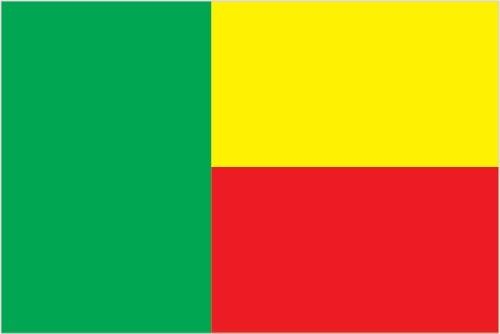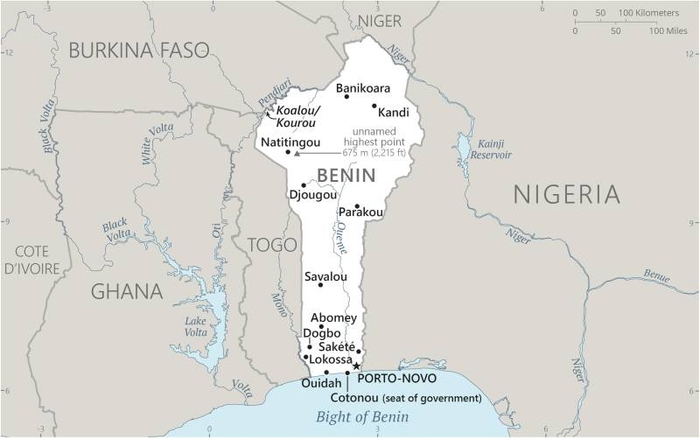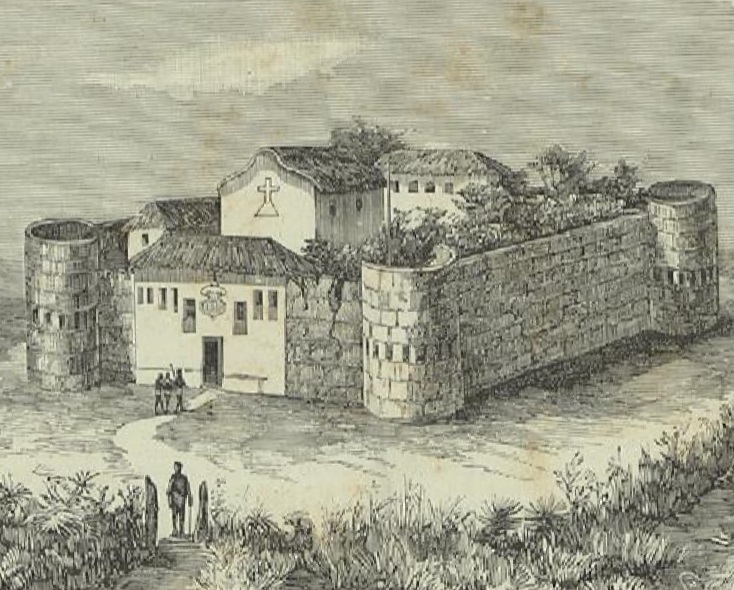179 Benin

Two equal horizontal bands of yellow (top) and red (bottom) with a vertical green band on the hoist side. Green symbolizes hope and revival, yellow wealth, and red courage.
Flag courtesy of the CIA World Factbook

Map courtesy of the CIA World Factbook

The Portuguese Empire was the longest European presence in Benin, beginning in 1680 and ending in 1961 when the last forces left Ajudá.
Government
According to Britannica, Benin has experienced much political instability and unrest. It suffered through 12 years of unstable government, including several coups d’état, beginning three years after independence. The regime of President Mathieu Kérékou, who came to power in a 1972 coup, enjoyed almost two decades of fragile but unprecedented stability. The Marxist rhetoric introduced in 1974 culminated in repressive military rule in the late 1970s, but this had largely ceased by the early 1980s. During this period, however, the Benin People’s Revolutionary Party (PRPB) was the only legal political party. A National Revolutionary Assembly, elected by citizens, chose the president, who was also head of state.
Benin was the first African country to make a post-Cold War transition away from Marxism-Leninism. In December 1989 Kérékou himself abandoned the Marxist-Leninist ideology that he had promulgated in the mid-1970s. In December 1990 a new constitution was approved, guaranteeing human rights, freedom to organize political parties, the right to private property, and universal franchise.
Under the 1990 constitution, Benin is a multiparty republic. The president, who is directly elected to no more than two consecutive five-year terms, serves as head of state and government. The president may be assisted by the prime minister, though the position is not required by the constitution and was vacant from May 1998–May 2011 and again from August 2013. Legislative power is vested in the National Assembly, consisting of members who are directly elected to serve four-year terms.
The constitution provides for an independent judicial branch of government. Benin’s judiciary comprises the Constitutional Court, which is the highest court in constitutional-related affairs, the Supreme Court, which is the highest court for administrative and judicial matters, and the High Court of Justice, which hears cases against the president and other government officials in matters pertaining to crimes committed while in office and high treason. The Constitutional Court and Supreme Court are located in Cotonou, while the High Court of Justice is located in Porto-Novo.
Civil / National Aviation Authority (CAA/NAA)
The National Agency for Civil Aviation (ANAC) is a public establishment of an administrative and technical nature, endowed with legal personality and financial autonomy. It is placed under the supervision of the Ministry of Infrastructure and Transport (MIT), enacted in 2013 by Law 2013-08 of August 9, 2013, on the Civil and Commercial Aviation Code in the Republic of Benin, in its article 5. Its missions are described in Decree No. 2019-141 of May 22, 2019, approving the statutes of the National Agency for Civil Aviation. The ANAC is responsible for ensuring, on behalf of the state, regulatory and control missions in the fields of aviation safety, security and the environment, in accordance with the Standards and Recommended Practices of the ICAO. Thus, it ensures the sovereign functions of supervision in matters of civil aviation. It implements the state’s civil aviation policy and represents it with all international civil aviation organization. The ANAC also controls the activities of all operators, namely: the aerodrome operator, the air navigation service provider, the airlines operating on the territory of the Republic of Benin, the airport security service providers.
Airspace
SkyVector – Google Maps – ADS-B Exchange
ICAO countries publish an Aeronautical Information Publication (AIP). This document is divided into three parts: General (GEN), En Route (ENR) and Aerodromes (AD). ENR 1.4 details the types of airspace classes they chose to adopt from classes A through G. eAIP ASECNA
Drone Regulations
Advanced Air Mobility (AAM) Regulations & Policies
None found by the author.
However, should you, the reader, happen to stumble across something to the contrary, please email the author at FISHE5CA@erau.edu and you may be mentioned in the ACKNOWLEDGEMENTS section of this book by way of thanks for contributing to this free eBook!
Advanced Air Mobility (AAM) News
None found by the author.
However, should you, the reader, happen to stumble across something to the contrary, please email the author at FISHE5CA@erau.edu and you may be mentioned in the ACKNOWLEDGEMENTS section of this book by way of thanks for contributing to this free eBook!
Short Essay Questions
Question 1
You have been hired by a Drone Startup Company. Your boss has immediately assigned this job to you.
They need you to prepare a one-page memo detailing the legalities of using a drone to film in Benin.
They need you to mention any national laws and local ordinances.
They specifically want to know what airspace you will be operating in and whether or not you need an airspace authorization.
Does it matter whether or not you are a citizen of the country?
Lastly, there is a bonus for you if, as you scroll through this chapter, you find any typos or broken links!
Question 2
Do you need a certificate to fly UAS?
If so, how do you obtain one?
Are there fees associated with this?
If so, how much?
Question 3
May you operate beyond visual line of sight?
If so, what procedures must you follow?
Question 4
Does the country have UAM/AAM laws? If so, describe, citing the exact law.
Question 5
Are you aware of any new laws or policies not mentioned above? If so, describe, citing the exact law or policy.

